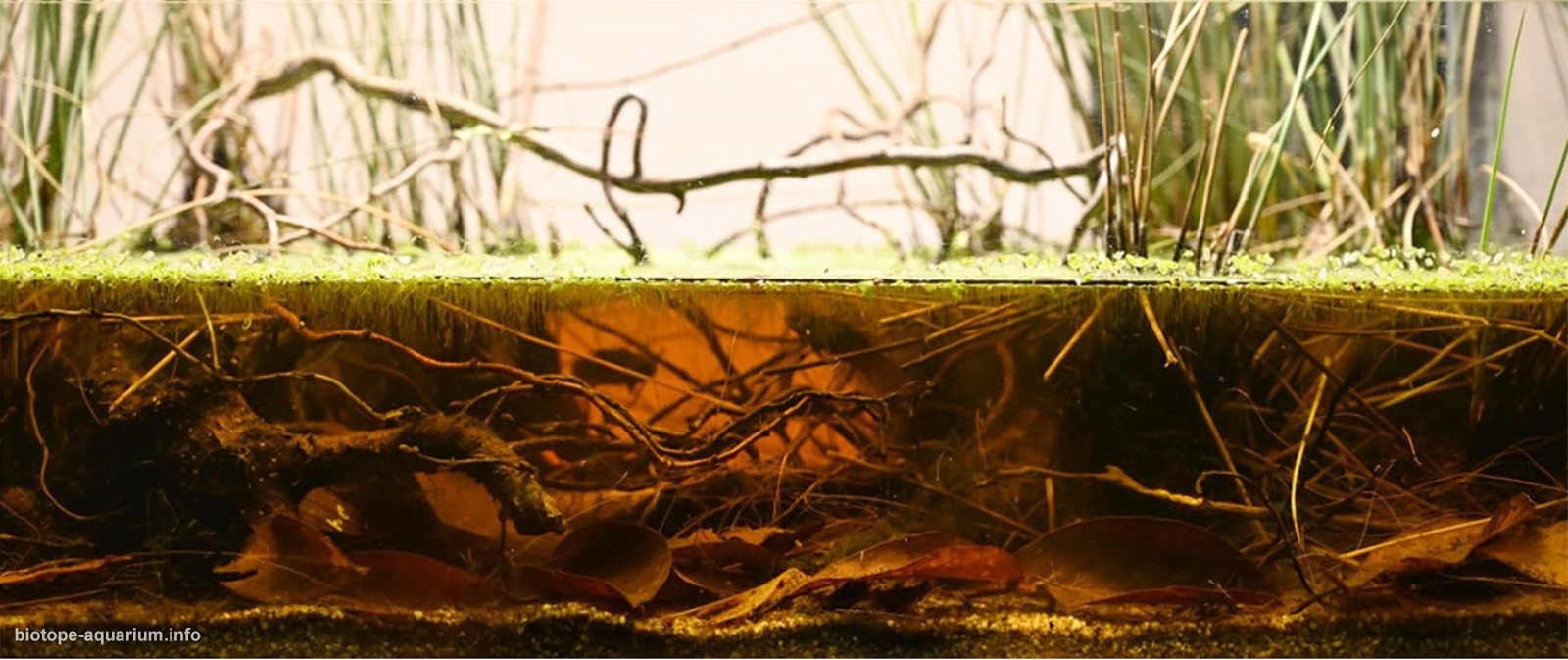Betta smaragdina Biotope, flooded land in Nong Bua Lamphu Province, Isan Region, Northeast Thailand
_th place in Biotope Aquarium Design Contest 2020

Volume: 45l
Dimensions: 60x40x20x18
List of fishes: Betta smaragdina
List of plants: Lemna minor, Juncus effuses, Pistia stratiotes
Description of decorations: Dried willow branches gathered near the river, sand having a granulation of 0.2-0.5 mm, covered with dried magnolia leaves.
Description of equipment: SunSun HW-603B external filter, 400 l/hrs. Suspended led lamp 50w, temperature color 6500k, 4 spectrum colours
Water parameters: Temperature: 26°C, pH: 7, GH: 10
Additional info: No water change, adding 3l every 3-4 days (twice per week).
INFORMATION ABOUT BIOTOPE
Description of the area surrounding the biotope: Isan is the north-eastern and the largest region of Thailand, located on the Khorat Plateau, bordered by the Mekong River (along the border with Laos) to the north and east, by Cambodia to the southeast; To the west it is separated from northern and central Thailand by the Phetchabun Mountains. Mekong river is the longest river in Southeast Asia. Has its source on the Tibetan Plateau at a height of 5200m. The river runs successively through the countries of China, Laos, Thailand, Cambodia and Vietnam. The name of the river in Vietnamese means: “the river of the nine dragons”. The Mekong is navigable by sectors, depending on the season (in the rainy season up to Vientiane; 1,600 km). The Mekong river has 7 tributaries. Isan is divided into 20 provinces. The Nong Bua Lamphu province was founded in December 1993, Nong Bua Lamphu became the 76th province in Thailand. Prior to the separation, Nong Bua Lampu was part of Udon Thani. Betta smaragdina is a species of betta fish native to norther east Thailand (Isan province) which is mostly mountainous area, and in Laos. Betta smaragdina are found in north-eastern Thailand at low altitudes in the upper Mekong basin and in its tributaries, such as Mun, among the Khorat mountains and high plateaus of the rural Isan region. The species can be found in the Mekong and neighbouring Laos. Betta smaragdina is considered the local fighting fish of the Isan people. The Isan area of Thailand covers over a third of the entire country and consists mainly of plateaus. This geographical feature is very isolating and helps to preserve Betta smaragdina, as well as to prevent the species from mixing with other bloodlines. Their habitat consists of shallow rice fields, ditches and low spaces next to rice fields. This buffer area is a free space that the farmer uses for releasing fish or for irrigating in and out of his rice field. This area is flooded most of the time, excepting maybe the dry season when the mud is dry. Actually, the farmer doesn’t use this area for rice culture so fortunately it is not affected by chemical products. This small area is a very complex and complete habitat. There are various types of plants, weeds and animals living here.
Description of the underwater landscape of the biotope: Water height is 12 cm; the colour is reddish-brown due to dried magnolia leaves, dried plants and wood which can be seen on the bottom of the water.
Description of the parameters of the habitat: The water is slightly brown, the temperature varies with seasons (24 – 27°C), pH is 7.
List of fishes and invertebrates occurring in the nature biotope: Betta splendens, Betta smaragdina and other fish species that partially breathe atmospheric air as an adaptation to this habitat; Freshwater shrimp species such as Macrobrachium spp. or Caridina japonica; Snail: Melanoides spp.
List of plants found in the nature biotope: Various species of magnolia (dried leaves fallen in to the water, coloring it in brown) Rice crops; Different Juncus species (growing in more isolated areas) and weeds; Floating plants: Lemna Minor, Pistia Stratiotes.
Threats to the ecology: Betta smaragdina is listed as difficult data by IUCN. This species is still very little known and the population is currently decreasing. The species is threatened by the permanent degradation of the natural habitats; Most of them have been transformed into intensively cultivated, developed or polluted agricultural land, especially in Thailand and Laos, which are the main target of wild populations. The genetic erosion is a secondary threat to the breeding stock escaped by B. splendens from wild habitats. It is indeed well known the fact that introducing domestic Betta into the natural habitat had a negative impact on the genetic purity of certain Betta smaragdina populations. Hybridization after releasing captive-bred is a real issue.
Sources of information:
